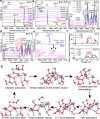Surface fluorination of BiVO4 for the photoelectrochemical oxidation of glycerol to formic acid
- PMID: 39289360
- PMCID: PMC11408720
- DOI: 10.1038/s41467-024-52161-4
Surface fluorination of BiVO4 for the photoelectrochemical oxidation of glycerol to formic acid
Abstract
The C-C bond cleavage of biomass-derived glycerol to generate value-added C1 products remains challenging owing to its slow kinetics. We propose a surface fluorination strategy to construct dynamic dual hydrogen bonds on a semiconducting BiVO4 photoelectrode to overcome the kinetic limit of the oxidation of glycerol to produce formic acid (FA) in acidic media. Intensive spectroscopic characterizations confirm that double hydrogen bonds are formed by the interaction of the F-Bi-F sites of modified BiVO4 with water molecules, and the unique structure promotes the generation of hydroxyl radicals under light irradiation, which accelerates the kinetics of C-C bond cleavage. Theoretical investigations and infrared adsorption spectroscopy reveal that the double hydrogen bond enhances the C=O adsorption of the key intermediate product 1,3-dihydroxyacetone on the Bi-O sites to initiate the FA pathway. We fabricated a self-powered tandem device with an FA selectivity of 79% at the anode and a solar-to-H2 conversion efficiency of 5.8% at the cathode, and these results are superior to most reported results in acidic electrolytes.
© 2024. The Author(s).
Conflict of interest statement
The authors declare no competing interests.
Figures





Similar articles
-
Solar-driven highly selective conversion of glycerol to dihydroxyacetone using surface atom engineered BiVO4 photoanodes.Nat Commun. 2024 Jun 28;15(1):5475. doi: 10.1038/s41467-024-49662-7. Nat Commun. 2024. PMID: 38942757 Free PMC article.
-
Selective Valorization of Glycerol to Formic Acid on a BiVO4 Photoanode through NiFe Phenolic Networks.ACS Appl Mater Interfaces. 2023 Mar 8;15(9):11678-11690. doi: 10.1021/acsami.2c20516. Epub 2023 Feb 21. ACS Appl Mater Interfaces. 2023. PMID: 36808942
-
C-C Bond Formation Coupled with C-C Bond Cleavage during Oxidative Upgrading of Glycerol on a Nanoporous BiVO4 Photoanode.J Am Chem Soc. 2023 Nov 22;145(46):25382-25391. doi: 10.1021/jacs.3c09631. Epub 2023 Nov 8. J Am Chem Soc. 2023. PMID: 37939244
-
Advancing BiVO4 Photoanode Activity for Ethylene Glycol Oxidation via Strategic pH Control.Molecules. 2024 Jun 11;29(12):2783. doi: 10.3390/molecules29122783. Molecules. 2024. PMID: 38930848 Free PMC article.
-
Vacancy defect engineering of BiVO4 photoanodes for photoelectrochemical water splitting.Nanoscale. 2021 Nov 11;13(43):17989-18009. doi: 10.1039/d1nr05691c. Nanoscale. 2021. PMID: 34726221 Review.
Cited by
-
Electrosynthesis of Chemicals from Biomass Glycerol.JACS Au. 2025 Jul 5;5(7):2977-2991. doi: 10.1021/jacsau.5c00644. eCollection 2025 Jul 28. JACS Au. 2025. PMID: 40747040 Free PMC article. Review.
-
Paired Chemical Upgrading in Photoelectrochemical Cells.JACS Au. 2025 Apr 23;5(5):2061-2075. doi: 10.1021/jacsau.5c00115. eCollection 2025 May 26. JACS Au. 2025. PMID: 40443900 Free PMC article. Review.
-
Selective photoelectrochemical synthesis of adipic acid using single-atom Ir decorated α-Fe2O3 photoanode.Nat Commun. 2025 Jun 2;16(1):5128. doi: 10.1038/s41467-025-60506-w. Nat Commun. 2025. PMID: 40456750 Free PMC article.
-
Machine-Learning-Guided Design of Nanostructured Metal Oxide Photoanodes for Photoelectrochemical Water Splitting: From Material Discovery to Performance Optimization.Nanomaterials (Basel). 2025 Jun 18;15(12):948. doi: 10.3390/nano15120948. Nanomaterials (Basel). 2025. PMID: 40559311 Free PMC article. Review.
References
-
- Luna, P. D. et al. What would it take for renewably powered electrosynthesis to displace petrochemical processes? Science364, eaav3506 (2019). - PubMed
-
- Sivula, K. & van de Krol, R. Semiconducting materials for photoelectrochemical energy conversion. Nat. Rev. Mater.1, 15010 (2016).
-
- Nocera, D. G. Solar fuels and solar chemicals industry. Acc. Chem. Res.50, 616–619 (2017). - PubMed
-
- Dodekatos, G., Schünemann, S. & Tüysüz, H. Recent advances in thermo‑, photo‑, and electrocatalytic glycerol oxidation. ACS Catal.8, 6301–6333 (2018).
-
- Zhang, Z. & Huber, G. W. Catalytic oxidation of carbohydrates into organic acids and furan chemicals. Chem. Soc. Rev.47, 1351–1390 (2018). - PubMed
Grants and funding
LinkOut - more resources
Full Text Sources

